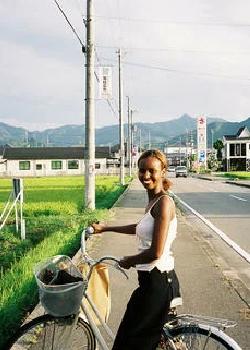Sasayama

By Nadifa Mohamed
Granta (2014)
Photography by Nadifa Mohamed
Review by Azmina Sohail
What happens when a young black Somalian woman coming from London meets the rural serenity of Sasayama, a city in Hyogo prefecture? The blending of two different cultures and an unspoken idea that the two may not be so different after all.
Sasayama published in Granta’s ‘Essays and Memoir’ page online, captures a memory of Nadifa Mohamed in the summer after graduation living with Mary, a fellow black woman whose ‘life in a new country’ she envied.
It can be argued that one of the most outstanding physical qualities of a black woman is her hair. The beauty of the Afro is that it is a particular texture that requires specific care and treatments. Mohamed is aware of this and notices that Mary had found a way to deal with the absence of black hairdressers by bringing ‘relaxers’ from London, had taught her friends ‘the art of straightening Afro hair’ and even explained the process of blow-drying Afro hair to the local hairdressers. Mohamed however had had a mishap with a home-dye kit and decided to visit this local salon to fix the ‘kaleidoscope of colours’.
The cycle ride through Sasayama details the epitome of rural Japan with the ‘heavy washing machines spinning in yards, discarded snake skins…rice paddies sibilant with crickets and tended by bent-backed old women wearing neon plastic visors.’ The imagery here connotes a homely life with laundry, food, and families - a stark contrast to her life in London she details later on. She finds peace in this environment saying ‘I felt far from home and free’.
When she arrives at the salon, it’s clear that she is not entirely comfortable as she ‘nodded awkwardly’ and gestures to her hair mimicking the blow-dry action. The owners however seem happy to help her and exclaim ‘Hai! Hai’(Yes! Yes)’ and lead her to the central chair in the room. They then attempt to style her hair with ‘paddle brushes’, dryers and flat irons, ‘sweating’ and ‘flushing’ around her. What’s interesting to note is that the owners themselves look different from what is associated with stereotypical rural life. The man is wearing ‘tight black trousers’, has ‘heavily plucked eyebrows’ and a ‘line of foundation along his jaw’ whilst the girl has a ‘row of empty piercings along the cartilage of her ear’.
In this moment, despite Mohamed not directly acknowledging it, both herself and the hairdressers are bound by the notion of “physical difference” in their environment. Mohamed being of a different race to her companions and the hairdressers having a different dress sense to those usually associated with rural Japan. In this moment a collision of cultures is occurring in a good way; Mohamed is learning to embrace the culture of Japan whilst the hairdressers are learning to embrace the art and beauty of Afro-hairdressing.
In the midst of the chaos, she thinks back to her life in London which is equally busy, fast-paced and full of life. London was uncertain, where ‘decisions need to be made, seemingly so quickly about where to work, where to live’ and ‘who to be’; the uncertainty matching those of the hairdressers. Then everything stops. The brush bounces on the floor snapping her out of her reverie. Her hair had not improved and instead was ‘large, newsreader-style and brittle with hairspray’.
Like a Londoner, she quietly accepts their efforts thanking them and bowing to show ‘no hard feelings’ and cycles back home to Mary ‘letting the breeze do the rest’.
The essay gives a brief insight into the notion of cultural diversity within rural Japan. Appearing physically different from those around them is something that both Mary and Nadifa recognise and embrace. The hairdressers, however, show a microcosm of the further visual differences within the Japanese community itself.
Both Mary and Nadifa are aware that diversity is something yet to develop within rural Japan but appreciate the efforts being made to embrace it. But it will take time and exposure to people like Mohamed for the people of rural Sasayama to fully embrace and understand the life of a young black woman.
* Edited from the original in February 2024

